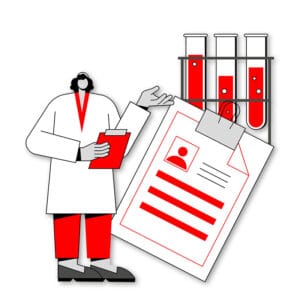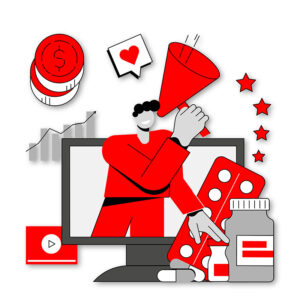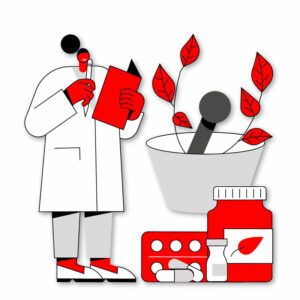B2B pharmaceutical marketing follows somewhat different rules than classic marketing by companies for companies. If you also want your pharmaceutical marketing strategy to be crowned with success, then read on.
Have you ever heard of the "Sissi syndrome"? The clinical picture, named after the Austrian Empress Elisabeth, describes (mainly) women who outwardly appear very active but are supposedly suffering from depression. The "Sissi syndrome" first appeared at the end of the 1990s in the context of various campaigns around B2B pharmaceutical marketing. Later, however, it turned out that the disease image was deliberately developed and disseminated by PR agencies in order to increase the awareness of their customers.
Fortunately, strict rules apply today, especially in B2B pharmaceutical marketing, which must be adhered to when developing a pharmaceutical marketing strategy. Read here what else needs to be observed in the field of pharmaceutical content marketing.
B2B Pharma Marketing: A brief definition
B2B Pharma Marketing refers to the distribution of pharmaceutical products such as medicines and vaccines with the help of targeted advertising measures. There are two main forms of pharmaceutical product distribution:
- OTC Marketing or Over the Counter MarketingThese products may be advertised publicly. In the pharmaceutical marketing mix, advertising spots, posters or online ads are classically used. It is always important to follow the well-known advice: "Ask your doctor or pharmacist about risks and side effects.
- Rx Marketing: These are prescription medicines. Public advertising is not allowed. Innovative pharmaceutical marketing must therefore focus on doctors, who then decide which products and therapies they prescribe to their patients.

Successful B2B Pharma Marketing: The Basics
Before starting the marketing campaign and choosing the right tools, the following four questions need to be answered:
1. what is being advertised?
Attention: Products are not always the focus of pharmaceutical marketing. Awareness measures can, for example, also aim to strengthen the perception of one's own brand as a whole or the awareness of relevant diseases.
What should the customer journey look like?
Another special feature of pharmaceutical marketing: only very few marketing measures lead directly to the sale of a product. The pharma marketing funnel is a form of healthcare communication and shows the typical customer journey: the customer perceives the product through advertising, for example. In the best case, this arouses interest in the product. If the customer is interested, he or she considers a purchase and may actually intend to make a purchase. For this to happen, the customer must first recognise his or her own benefit for the product. In the best case, one then decides to buy. This simple principle applies to all product marketing, especially in the B2C sector. In the B2B sector, it is usually the case that customers are already deeper in the marketing funnel and a purchase is therefore even more obvious.
In order to convince doctors of a product, it can therefore be helpful to first inspire them to participate in a seminar.
3. where to advertise?
This is not simply a decision between online and offline advertising, but a deeper understanding of where the target group can best be reached: Where do doctors or pharmacists obtain information on medical issues and from whom? Which magazines, platforms or newsletters are relevant for them?
4 What message should be sent?
To answer the last question, the marketer's understanding of the relevant topics and questions for the target group is essential. For this, the current station in the customer journey is also of high importance. For example, general study data may be important for a doctor at the beginning, while specific case studies may be of much more interest to him or her at a later stage in the customer journey.
Once these questions have been clarified, pharmaceutical distributors have a wide range of B2B marketing tools available.

What are the most important marketing tools in B2B Pharma Marketing?
Consumer:inside Marketing:
This includes all measures that directly address consumers, which is why they are primarily suitable for non-prescription OTC products.
Offline
- Print advertising: advertisements in magazines, newspapers and (trade) magazines
- PR articles: paid articles in print media that are wholly or partly aimed at presenting a product or a company
- TV & Radio: Advertising clips with a mostly very broad reach
- Poster advertising: posters and notices on public advertising spaces
- In-store marketing: displays or advertising signs, e.g. in the pharmacy.
- Referral marketing: convincing pharmacists of the products through the sales force so that they recommend them to the end customers.
Online
- SEA: paid ads that are displayed above the first results in Google searches
- SEO: Development of relevant content (e.g. articles, videos) that rank among the first hits in Google searches.
- Banner advertising: Advertising space on websites
- Social media ads: Advertisements displayed to users on social media (e.g. Instagram, Facebook, etc.).
- Online videos: Videos on websites or as short advertisements in front of a
- Influencer marketing: Presentation or promotion of a product by media influential persons.
- Email marketing: promotional emails or newsletter articles to your own distribution list or a paid article in the newsletter of a company with a large reach.
Referral/recommendation marketing:
Prescription medicines may only be advertised to doctors or healthcare professionals. Therefore, the measures here are primarily directed at prescribers. But doctors and pharmacists can also be important multipliers for non-prescription medicines. Here, pharmaceutical companies benefit from the high degree of trust that people have in recommendations from experts.
- Seminars: Training measures for doctors in which, for example, therapeutic approaches, the use of certain medicines and case studies are discussed.
- SEO: specialist content developed for doctors that can be found via Google
- SEA: paid ads for content displayed above Google search results.
- Email marketing: targeted email campaigns or newsletters for medical professionals
- KOL Marketing: Collaboration with influential opinion leaders who present the product, for example as a testimonial or as a testimonial.
- Social media/specialist communities: Addressing decision-makers and disseminating specialist content via networks and specialist communities
Awareness Marketing:
Awareness marketing is not about promoting products directly, but first of all about creating awareness for a topic. In B2B pharmaceutical marketing, two forms are popular here:
a) Brand Marketing: The aim here is to increase awareness and the To increase the reputation of one's own brandso that this will later rub off on the specific products.
b) Diseases Awareness Marketing: For lesser-known conditions or diseases that are taboo, it can be important to first create general awareness. Such campaigns can address both doctors and people affected, with the aim of actively addressing and treating the disease.
SEO in B2B Pharma Marketing:
Develop targeted content that appears in Google searches on the company or on specific diseases.

3 Aspects of B2B Pharma Marketing
For a long time, it seemed as if the ravages of time would not affect the pharmaceutical industry. While other industries were in part completely turned upside down, here much remained the same - especially in sales, people continued to rely on the tried and tested field sales force and personal talks with doctors. But for a while now, the signs in B2B pharmaceutical marketing have been pointing to change, and since the pandemic at the latest, it should be clear to everyone that a far-reaching rethink is necessary in order to remain competitive as a pharmaceutical company in the future.
The following three aspects have a particularly strong influence on the marketing of pharmaceutical companies:
1. information procurement
For the vast majority of German doctors, online research has long since become part of their daily work. More and more doctors are specifically using online platforms, Google searches and social networks to find out about medicines, therapies and new scientific findings. For the younger generation in particular, the trend clearly indicates a move away from field visits to digital channels. For B2B pharma marketing, this means profound strategic changes: On the one hand, these channels require innovative formats and content that are precisely tailored to the needs of the target group. On the other hand, internal structures and processes have to be adapted in order to effectively combine new and old channels.
2. digitisation
From video calls and health platforms to health apps and smart sensors and devices, more and more new technologies are finding their way into everyday pharmaceutical life. On the one hand, this requires continuous adjustments of marketing teams and strategies. On the other hand, it offers completely new opportunities for value creation that extend far beyond the effect of a medicine. For example, pharmaceutical companies can actively support treatment by developing innovative offers for patient education, pre- and post-treatment and treatment support. At the same time, the role of data is becoming increasingly important in order to effectively manage sales processes, develop new solutions and convince the target group with personalised content.
3. the role of the patients
Practice shows that the focus on doctors alone is no longer sufficient. Patients are increasingly taking their health into their own hands. A large part of the population informs itself extensively online about medical topics, exchanges information with other patients and takes a much more active role in their treatment. Therefore, treatment and the development of new products must be increasingly oriented towards the needs and habits of patients. It is not enough to only mention patient issues in communication with prescribers. The considerable influence of patients on the choice and success of their therapy means that they must increasingly be addressed directly.
Pharmaceutical companies transform from drug manufacturers to health care providers
The consequence - nowadays it is about much more than simply combating symptoms with tablets or ointments. Topics such as prevention, quality of life and treatment-supporting measures are increasingly coming into focus. For pharmaceutical companies, this means a change from drug manufacturer to health care provider. The aim is to develop holistic solutions for health problems that integrate all stakeholders with the help of targeted content and in which the company's own product fits in like a building block.
B2B Pharma Marketing
Especially in the pharmaceutical industry, there are strict legal requirements that must be observed when developing a pharmaceutical marketing strategy. We know what matters and define the campaign goals with you and then develop a customised pharmaceutical marketing concept.
Four driving trends in B2B pharma marketing
In response to the changes in the pharmaceutical industry, four trends have developed in B2B pharma marketing that need to be implemented in pharma marketing to make sales fit for the future.
1. content marketing in B2B pharma marketing
Marketers and salespeople in B2B pharmaceutical marketing are increasingly dependent on picking up their target group where they are actively looking for information. In addition to the classic push approach of the sales force, a clear strategy is needed to reach them as early as possible in the decision-making process with the help of relevant online content (pull approach).
At first glance, pharmaceutical marketing may seem more complex and difficult than classical marketing strategies. This was undoubtedly the case, especially in the early days of pharmaceutical marketing. Until today, however, the pharmaceutical industry has established itself so firmly and solidly in the market that there is close and, above all, highly success-oriented cooperation between the advertising companies and relevant associations and institutions. These are extremely valuable in terms of promising B2B pharmaceutical marketing. Moreover, in the course of this, it is possible to view the legal requirements not as a restriction, but rather as an opportunity or as goal-oriented benchmarks.
2. digital formats
To produce effective online content, the sales team in B2B pharma marketing needs digital competence. The question is which online formats and content work for your target group. This can really only be found out through trial and error. On the other hand, the sales team needs to understand what impulses each of these measures is intended to exert on the decision-making process (e.g. create attention, build contacts, etc.).
3. omni-channel marketing
Central to the success of a digital sales strategy is the interaction of the different channels. Field sales and digital channels must be linked in B2B pharma marketing in such a way that the needs of the target group are always the focus. The goal here is that the individual actions (e.g. online contribution, email campaign, sales talk, etc.) interlock in such a way that the doctor feels optimally supported in the decision-making process at all times.
4 Patient Centricity in B2B Pharma Marketing
In addition to doctors, patients are also exerting more and more influence on the management of their health. For them, it is not only the success of the therapy that counts, but all patient outcomes, such as quality of life, pre- and post-treatment care and the integration of the treatment into everyday life. For pharmaceutical companies, this means that they must increasingly offer solutions with "Beyond the Pill" approaches that go beyond the effect of the medication to meet the needs of those affected.

B2B Pharma Marketing Mix: The 7 P's
The 7 P's of the B2B Pharma Marketing Mix consist of the four general marketing mix factors and an additional three factors that tailor the content of the marketing mix even more specifically to the topic of pharmaceutical industry business:
-
- 1. product: Product variation, product differentiation, product innovation, product elimination, quality, branding, warranty, service, packaging
- 2nd Place: Distribution channel (digital), direct sales, indirect sales, e-commerce, retail, wholesale
- 3. price: Cost recovery price, penetration price, skimming price, discounts, letter of credit terms, list price, price bundling
- 4. promotion (of the content to the target groups): Individual communication, mass communication, brand, corporate identity, advertising (content) and campaign, promotions, direct marketing, direct mailing, brochures/posters
- 5. player: Consumer requirements, needs, expectations, demands
- 6. process: Communication processes and procedures between the advertising company and target groups
- 7. positioning: Positioning of the preparation with regard to the service portfolio on the market (in close context to player and process)
We speak "pharmaceutical" fluently
Pharma marketing in the B2B sector is a very special playing field and as you might have seen now, it requires a special know-how. Therefore, rely on an absolute expert. We have perfected the language of the pharmaceutical industry and medical experts and speak "pharmaceutical" fluently. Numerous customers like Allergopharma, ALK Abelló and even the representation of interests of the pharmaceutical industry in Austria, PHARMIGare already convinced by us. Now we would like to convince you too and look forward to a chat.








